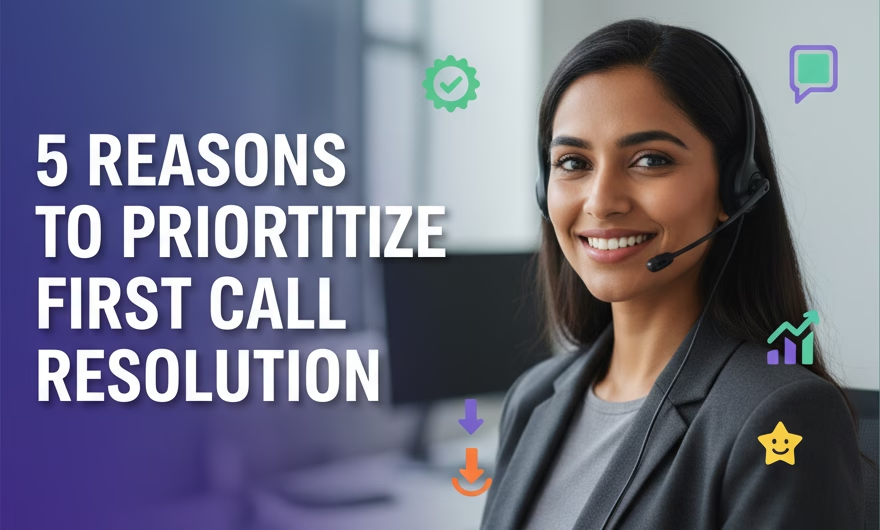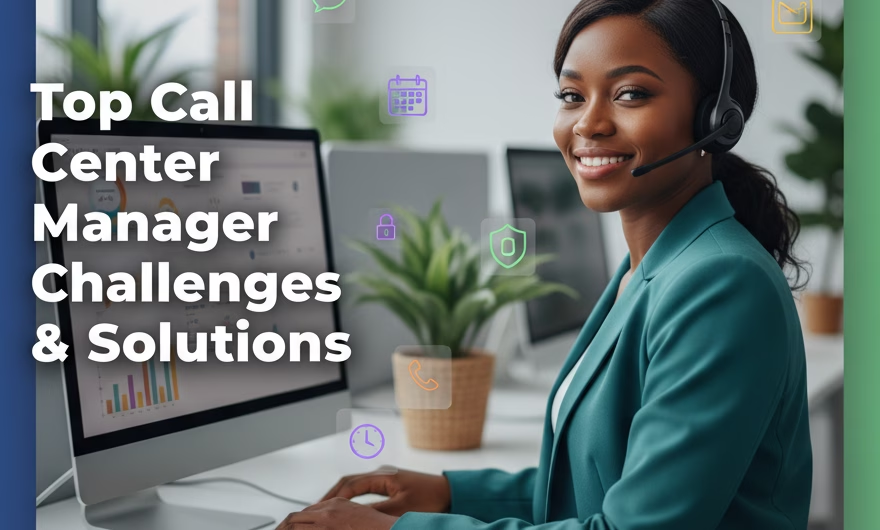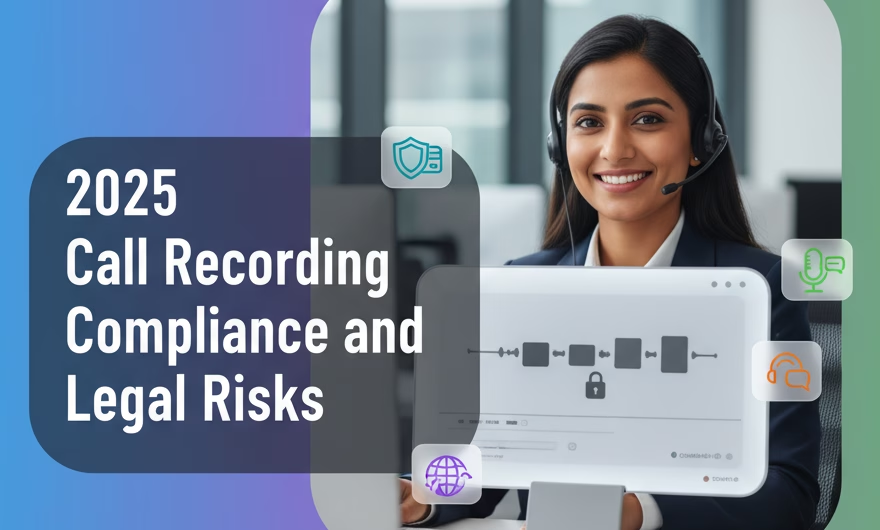A large number of organizations have heard about First Call Resolution (FCR), but only a handful truly understand its gravity. It often becomes a peripheral concern regardless of an organization’s size, scale, or target market as they seek measures to improve contact center efficiency and handle issues swiftly. Yet, resolving customer issues in a single interaction is one of the most effective ways to reduce effort, cut costs, and elevate the experience.
As of 2025, First Call Resolution continues to gain attention among customer support and contact center specialists as a key driver of customer satisfaction, while its consistent, disciplined use as a metric still lags. Improving FCR rates offers several direct benefits that reach beyond the contact center, influencing operating costs, employee engagement, and long-term customer value.
Reduce Operational Costs
FCR dramatically reduces costs by directly impacting repeat calls. Every unresolved interaction creates rework—follow-up contacts, escalations, and back-office tickets—that inflate volumes and drive up cost-to-serve. When customers get a complete solution the first time, you prevent additional contacts across voice, chat, email, and messaging, while also reducing queues and average speed of answer for everyone else.
A 15% increase in FCR results in a 57% reduction in repeat calls. Beyond fewer repeat contacts, stronger FCR also improves planning accuracy and stabilizes operations. With fewer unexpected callbacks and escalations, staffing models become more predictable, occupancy levels stay healthy, and you can manage peak loads with less pressure on overtime or temporary staffing.
- Lower rework and back-office processing due to fewer case reopenings
- Reduced escalation volume and associated supervisory time
- Improved forecasting and scheduling accuracy as repeat-contact noise declines
- Less strain on systems and self-service due to fewer follow-up attempts
Improved Customer Satisfaction
An increase in FCR corresponds to an improvement in customer satisfaction. Customers reach out because they want outcomes, not transfers or callbacks. When an issue is resolved on the first attempt, it signals competence and care—two attributes customers reward with higher satisfaction and advocacy. Even if the answer is “no,” delivering a clear, complete resolution with empathy and ownership typically earns more goodwill than a partial fix or a promise of future follow-up.
As customer journeys now span voice, chat, messaging apps like WhatsApp API, and email, many organizations evolve FCR into First Contact Resolution—measuring whether the issue is resolved without the customer needing to reach out again through any channel. Regardless of channel, the principles are the same: understand the need completely, take end-to-end ownership, and close the loop. That lowers customer effort and directly elevates CSAT and NPS.
- Set clear resolution criteria so “done” means no further action is required
- Use knowledge articles and guided workflows to deliver complete answers
- Proactively confirm resolution before ending the interaction
- Follow up only when truly necessary—and with a specific, agreed timeline
Agent Satisfaction and Rewards
Many contact centers historically used handle time to evaluate agent performance, which can incentivize agents to end calls quickly rather than thoroughly. Emphasizing resolution on the first call shifts the focus to quality outcomes, enabling leaders to recognize and reward the behaviors that matter: active listening, diagnosis, and end-to-end ownership. When agents are evaluated and coached on resolution, they gain permission to do the right thing for the customer.
This approach also improves agent experience. Fewer repeat contacts mean fewer frustrated customers coming back, less firefighting, and less emotional strain. With better tools—unified agent desktops, integrated CRM context, and in-flow knowledge—agents can resolve more issues independently, which increases confidence and engagement. Over time, this reduces burnout and attrition while improving consistency in service delivery.
- Use balanced scorecards that include FCR, quality, and customer feedback alongside time metrics
- Coach to root-cause discovery and next-issue avoidance rather than speed alone
- Empower agents with clear policies to resolve issues without unnecessary approvals
- Celebrate “first-time-right” wins to reinforce desired behaviors
Increase Customer Revenues
Resolving issues on the first call makes customers more receptive to upsell or cross-sell activities. Trust is a prerequisite for growth; when you quickly remove friction and deliver value, customers are more open to hearing about complementary products, higher-tier plans, or add-on services that genuinely solve adjacent needs. Conversely, unresolved issues lead to frustrated customers who are less likely to engage in further business and more likely to question renewal decisions.
Timing and intent matter. The best revenue moments come after a clear resolution, not during the diagnostic stage. When agents or digital flows are enabled to detect need and relevance—based on the resolved issue, customer profile, and past interactions—value-added offers feel helpful rather than salesy. Even when you defer any offer until a follow-up communication, a recently resolved issue sets the stage for a positive response.
- Train agents to prioritize resolution, then introduce offers that align with the solved need
- Use contextual cues (e.g., plan limits, product fit) to personalize recommendations
- Leverage post-resolution surveys and journeys to re-engage with relevant options
- Measure conversion and retention for offers made after a resolved interaction
Gain Customer Loyalty
Addressing customer concerns on the first call helps customers feel acknowledged and valued, reducing their inclination to switch companies. In markets where alternatives are easy to find and onboarding is simple, loyalty is earned through low effort and consistent outcomes. FCR demonstrates that when customers need help, you deliver promptly and completely—an experience that compounds over time into trust.
Loyalty is reinforced when organizations combine first-time-right service with transparency and recovery. If a resolution requires additional steps, set explicit expectations and meet them. If something goes wrong, own it and make it right without forcing customers to chase updates. These practices show reliability and respect, turning moments of friction into moments of loyalty.
- Define and communicate “no-repeat-contact” standards for common issues
- Proactively surface known issues and workarounds to prevent inbound contacts
- Use closed-loop follow-up sparingly, with clear owners and timelines when needed
- Offer meaningful make-goods when service falls short to protect the relationship
In the end, First Call Resolution is more than a metric—it’s an operating discipline that improves costs, satisfaction, and growth when embedded into processes, technology, and coaching. By designing for complete outcomes, equipping agents with the right tools and authority, and measuring what truly matters across channels, organizations can reduce rework, delight customers, and create conditions for long-term loyalty. Aim for resolution on the first interaction, and you’ll elevate both the customer experience and your bottom line.




